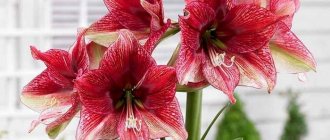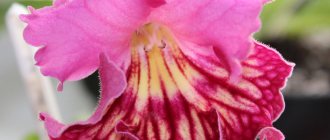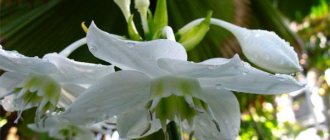Author: Tamara Altova. December 02, 2018
Category: Houseplants.
Crocuses are delicate, charming flowers that appear in the garden at the very beginning of spring. However, you can admire crocuses in winter if you plant their bulbs for forcing. Under certain conditions, you can get blooming crocuses both for the New Year holidays and for International Women's Day. These flowers are easily forced during the entire cold period. We will tell you when to plant bulbs in order to get flowering crocuses by a certain date, and also share the secrets of caring for flowers at home.
Description of the plant
Crocus
in a pot can become a bright accent for the spring and winter holidays.
This plant is
very tender and delicious.
It usually begins to bloom in the spring, after the snow has melted, a little later than snowdrops. Some varieties of Crocuses
may bloom in autumn.
Homeland of Crocus
is located in the tropics of the Mediterranean, but even in our climate it lives quite comfortably.
If to Crocuses
If you apply specific methods, you can achieve their flowering for a specific holiday, for example, the New Year.
The best varieties
The structure of crocuses has one peculiarity. They do not have long stems on which leaves grow. The short peduncle is covered with scaly wrappers, the leaves and peduncle rise directly from the ground, growing from the bulb. The inflorescences of crocuses are shaped like bells looking into the sky or embossed glasses of various colors. Inside them are orange-yellow pistils and stamens.
Nowadays, gardeners most often use two varieties of Crocus: autumn- and spring-flowering. In plants that bloom in spring, leaves form only after the inflorescence has withered. In autumn crocuses, leaves appear either in the spring and die off in the summer, or in the fall - at the time of bud formation. The root system of plants is small tuberous scaly bulbs of a flattened or spherical shape, in the lower part of which short fibrous threads of roots grow.
Decorative Crocus species are popular among gardeners.
Among them:
- C.Speciosus (beautiful) is a group of large-flowered autumn-flowering varieties of the same type, with fragrant inflorescences from 7 to 12 cm in diameter. Their leaves come out of the ground in the spring, die off in the summer, and flower buds appear only in September. The Cassiope variety has the most delicate blue inflorescences, Aitchisonu is decorated with lilac flowers, Conqueror - azure blue, Artabir - sky blue with dark veins.
- C. Pallasii (palassa) - blooms in autumn, forms lily-shaped inflorescences, the diameter of the flowers and the height of the peduncle does not exceed 5 cm. The petals are pink-lilac with whitish veins, the stamens are yellow.
- C. Vallicola (valley) blooms at the end of September, the height of the peduncle is about 10-12 cm, there are purple stripes on the central part of the milky flower petals, and orange streaks at the base.
Among the popular spring saffrons are:
- Crocus Tommasinianus (Tommasini): varieties Rubi Giant, Taplow Ruby. They are characterized by inflorescences of lilac-pink shades, elongated funnel-shaped, with bright yellow stamens.
- Crocuses of the Chrysanthus species (golden-flowered): varieties of yellow shades - Gipsy Girl, Cream Beauty, violet-blue - Blue Peter, Blue Bird, white varieties - Snow Bunting White Beauty. Flowers are characterized by different colors of outer and inner petals and striped leaves.
In total, over the long history of saffron breeding, more than 300 varieties of crocuses have been bred. Nowadays, about half of the varieties created by people are used in decorative floriculture.
Crocus at home - planting and care
Choosing a pot
Crocuses
usually planted in wide pots with a shallow bottom. Plant rooting in them is very favorable. A good layer of drainage must be placed at the bottom of the pot, after which soil with excellent air and water permeability is filled.
The reaction of the soil in the pot should be neutral. Its beneficial properties mean absolutely nothing, since for future growth and flowering all the most necessary and necessary properties are located directly in the bulb.
Flower growers who are aware of such secrets force the flower in sand or expanded clay.
Planting bulbs for forcing
The container for growing crocuses is wide and shallow, immersing the bulbs only halfway into the substrate. It is advisable to plant bulbs of the same type in a pot, that is, approximately the same size, then the flowering will be friendly and elegant. Moreover, the more bulbs in the container, the more magnificent the crocuses will bloom.
Suitable substrates for forcing include materials such as perlite, sand, gravel, soil, hydrogel, expanded clay or small pebbles: all reserves for flowering and growth of the crocus are contained in the bulb itself, so the composition of the soil is practically unimportant. Most often, river sand thoroughly washed with running water is used to grow crocuses at home.
After planting, the forcing is watered, and then the pot with the bulbs is kept for the time indicated in the table in the refrigerator or in a dark basement at a temperature of 9 ºC, maintaining the substrate in the pot in a moderately moist state. Then the temperature is lowered to 5 ºC to prevent intensive shoot growth later. During the cooling period, crocus bulbs take root and accumulate growth substances. Make sure that there are no temperature fluctuations above 9 ºC, otherwise the crocuses may not bloom.
Bulbs purchased in a store in the fall, after planting for forcing, require a cooling period just as much as planting material grown with one’s own hands. Bulbs purchased in a store in winter do not need refrigeration, since they have already been stratified under industrial conditions.
Care for long-term flowering
If your Crocuses
stopped blooming, and you want to identify the reason for this, you need to analyze the conditions of their maintenance.
It should be remembered that Crocus
is the first spring flowering plant and it may simply not like temperatures of twenty degrees or higher or an overly bright room.
In order to prolong the flowering of home Crocus
, it must be removed away from direct sunlight or bright light from a lamp. The temperature should be kept cool. During the day it is usually 15 degrees, at night 0.
If you care for the plant correctly, you can keep the plant decorative for up to three weeks.
How to plant crocuses (video)
White crocuses
Spring crocus blooms almost immediately after the soil warms up a little. From one tuber grows one (rarely two) flowers, usually white (but these flowers can also be purple). Flowering of this variety lasts about a month. These flowers can grow up to 16–18 cm in height, their foliage is dark emerald green with a silver line in the middle, and the bulb of this flower is flattened.
Crocus beautiful can bloom with white flowers, as well as different shades of blue and purple. The foliage of this plant can reach 28–30 cm in length. The buds appear in autumn.
Other common white-budded crocuses are:
- "Joan of Arc";
- "Catherine Perlow";
- "Snowstore";
- "Snowbending";
- "Albus";
- Saffron Heuffeliana.
Crocus beautiful can bloom with white flowers
Yellow crocuses
Crocuses with yellow flowers include the following types:
- Saffron is narrow-leaved with a peduncle height of up to 10 cm, blooming in the first ten days of April with yellow flowers with brown stripes along the outer part of the petals.
- The crocus is yellow with a peduncle height of up to 8 cm, its buds are orange with a golden tint. Buds appear in the first ten days of April.
- Crocus susiata with a peduncle height of up to 10 cm, the color of the buds is yellow with a golden tint, the plant blooms in the first ten days of April.
- Crocus Korolkova with a peduncle height of up to 8 cm, yellow buds with an orange tint, purple stripes on the outside of the petals. Blooms in the first ten days of April.
- Golden-flowered crocus with a peduncle height of up to 7–8 cm, small yellow buds.
- “Cream Beauty” – with yellow buds.
Yellow crocuses bloom in the first ten days of April
Lilac and purple crocuses
- Adams crocus with a small peduncle (up to 6 cm long). The color of the flowers can vary from lilac with a light shade to purple with a dark shade of flowers. Their throat can be yellow or white. These beautiful flowers bloom in the first ten days of April.
- Crocus Batana with a high peduncle (up to 14 cm). Their flowers look like small funnels of a soft lilac color. They bloom in the first ten days of September.
- Crocus Heifel with a peduncle height of 11-12 cm, blooming in the first half of April.
Other saffron varieties with similar flowers:
- "Agnes";
- "Vangard";
- "Artabir";
- "Violet Queen";
- "Nigro Boy";
- "Paulus Potter";
- "Pallux";
- "Purpureu Grandiflore";
- "Remembrance";
- "Flower Record".
Crocus Batana blooms in early September
Possible problems during cultivation
At Crocuses
, which bloom in spring and autumn, do not always have the same development cycles, and therefore the time of planting. This means that autumn types of flowers must be planted in the summer, and spring flowers in the fall, in September.
When purchasing material, you should always pay attention to the flowering season. For forcing, the spring type of Crocus
.
If tubers of different sizes and varieties are planted in one pot, then they will begin to bloom, accordingly, at very different times with different colors. And, of course, it will not look the most aesthetically pleasing.
Natural varieties of potted plants are not very decorative. And even with the most careful care of them, they will still be small. For them, planting in the garden is most suitable. For crops intended to be grown in pots, large-flowered plant varieties should be chosen.
If Crocus
The leaves have turned yellow, this is the first sign of chlorosis. This disease usually results from unfavorable conditions such as poor nutrition, poor drainage or damage to the bulb.
Varieties of crocuses for growing on a windowsill
To grow saffron at home, it is recommended to choose varieties from the group of Dutch hybrids. They are distinguished by their durability, unpretentiousness and spectacular flowering. The following types are especially popular:
| Variety name | Color of petals and buds | Flowering time | Peculiarities |
| "Remembrance" | The bud has a purple or bluish tint, the stamens are bright yellow. | One of the earliest primroses, it begins to bloom in early March. | It is large in size and ideal as a winter houseplant. |
| "Vanguard" | It has a pronounced purple tint to the buds. | End of March – beginning of April. | With proper care, it can be grown on a windowsill or flower bed. |
| "Joan of Arc" | A characteristic feature of the variety are snow-white petals and yellow stamens. | When favorable conditions are created, it begins to bloom in April. | Excellent for growing indoors in pots. |
To make the primrose pleasing to the eye longer, you can prolong its flowering artificially: during the period of setting buds, it is recommended to take the plant into a room where a low temperature regime is observed, which is no more than +16°C. This simple trick will extend the flowering period by several weeks.
Diseases and pests
If you notice that the petals on your plant are deformed and do not open, and light spots have appeared on the buds, then it is probably Crocus
affected by a viral infection.
In this case, the plant should be immediately destroyed, and the soil in which it was located should be treated with potassium permanganate.
Crocus bulbs
may be affected by fungus. In this case, they become soft, and spotted formations begin to appear under their scales.
Before planting, to prevent fungal diseases, the bulbs must be thoroughly dried and treated with special means.
What to do next with faded crocuses (can they be replanted)
Forced crocuses are considered a disposable product and are usually destroyed after flowering, because the corm in poor soil is depleted and cannot perform its further functions.
If you took care of the flower to grow further in advance, planted it in a large deep pot, nutritious soil, extended its flowering period to 3 weeks, then you can hope that its corm will not die off. The plant can either be grown further as an indoor flower with a long dormant period, or its bulbs and children can be transplanted into open ground after drying and keeping in the cold.
Primroses in the spring garden are always a joy, especially when bright saffron inflorescences peek out from under the snow. Crocus for the holiday is double joy. Receiving a living flower as a gift and replanting it in a flowerbed - isn’t this what amateur flower growers dream of? Fortunately, many people succeed.
Caring for Crocuses in the open ground
On Crocus
They are grown quite easily, since their care is practically minimal. The most difficult thing in the whole process is probably digging up and planting the tubers. But you don't need to do it every year.
Water crocuses after they are planted and until the end of the flowering period. If the winter was not snowy, then the flowers will need early watering in the spring.
Crocus
is a drought-resistant plant. It does not tolerate excessive soil wetting, although the height of its flower stalks depends directly on the amount of moisture received by the bulbs.
From time to time, from the moment the bulbs sprout until the end of flowering, you should loosen the soil under the flowers. Crocus tubers
need air flow. If loosening is not carried out, the air will be blocked by the soil crust that forms on the surface.
It is necessary to very carefully weed the flowers from weeds that take away nutrition from the bulbs. In many species of Crocus
Due to the lack of leaves, which appear only when flowers appear, weeds can significantly reduce the decorative value of plantings.
Plants need to be fed often and a lot. They really prefer organics. It is applied twice during the growing season. But it cannot be fresh manure, only rotted material.
Plants also have a great need for minerals. Especially in potassium and phosphorus. Twice in one season you can add a combined mineral complex.
The first feeding of spring plants is best done with a complex of minerals while still in the snow. And autumn ones are fertilized two weeks after planting with organic matter.
After the plants fade and the leaves turn yellow, care stops until the very moment of digging.
Crocuses after flowering
If you plan to plant the bulbs into the garden after flowering, continue to water the potting medium until the plant's leaves have completely turned yellow. After the leaves die, the corms are removed from the pot and stored until autumn planting in the ground in dry peat at room temperature. With the onset of autumn, large children are separated from the corms and planted in the garden for growing. In the spring, only some of the daughter bulbs will form flowers, but after two years each of the children will be ready for forcing.
4.5 Rating 4.50 (4 Votes)
- Back
- Forward
How to grow a plant from seeds
This method of propagating Crocuses
is used extremely rarely, since plants planted in this way begin to bloom only five years after they are planted in the soil.
To grow crocuses
Thus, it is necessary:
*Sow seeds in spring at the end of March or late autumn. The seeds are first soaked in a growth stimulator for forty minutes, after which they are placed in a weak solution of potassium permanganate.
*Before sowing, seeds should be stratified. Pour wet sand into a not very deep container and sow seeds in it. There is no need to bury them in the ground; simply distribute them on the surface. Cover the top with film and place in the refrigerator in the vegetable compartment. The container should be kept there for three weeks.
*When the time comes, remove the container from the refrigerator and place it in a bright and warm place.
*After the seedlings appear, they need to be watered. For watering, it is recommended to use a fine spray.
*When the plants grow a little, they are planted in separate containers or directly in the flowerbed.
Features of planting bulbs for balconies
When growing any bulbous plants on a balcony or loggia, follow the general rules for planting bulbous plants in containers. It is best to study agricultural techniques for each type of plant individually, but there are still general planting principles.
- Bulb crops are always planted at a depth equal to three times the height of the bulb itself (measured from the bottom).
- It is not worth planting the bulbs too densely, since the plant is not driven out for more spectacular flowering, but is preserved and grown from year to year, and for normal growth and development it is necessary to provide a sufficient amount of free soil. The planting distance is selected in accordance with the preferences and size of a particular species. So, for crocuses the optimal distance is 5-6 cm, and for tulips - 10-12 cm.
- The substrate needs to be given more attention. For bulbous pots, light, loose, water-, breathable and necessarily nutritious soil is selected. If you make it yourself, then mix equal parts of sand, peat, turf and leaf soil. It is not advisable to use vegetable or garden soil, but if you want to save money or have no choice, be sure to improve it by adding organic fertilizers, sand and peat.
- A layer of drainage must be laid at the bottom of any container or container in which bulbs are planted. For bulbous plants, its minimum height is 5-6 cm.
- After planting, provide stable light moisture for rooting.
It is not necessary to plant only one bulbous plant in a container - they can be planted in groups or mixed together to create bulbous compositions. At the same time, the main principle of planting bulbous plants in pots is observed - arrangement in tiers. Planting is carried out from large plants to small ones, taking into account that such plants are planted at different depths and at different distances between the bulbs.
Tulips and daffodils are placed first, sprinkled with soil and the next tier of plants are placed - hyacinths or muscari, and then even smaller primrose bulbs. But when planting different bulbs together, try not to forget about an individual approach and do not thicken the plantings too much, leaving enough space for normal root development and access to nutrients.
Layout of flower bulbs in a container
Crocus or saffron?
Beginning plant growers and people far from botany may consider these two plants to be different species. In fact, the correct name of the plant is saffron ; the name “crocus” is borrowed from Latin.
Saffron is also the name given to the spice obtained from the plant, which is why the flower itself is called crocus to avoid confusion. Both names may be used.
Crocuses belong to the Iris family. This is a perennial corm-like herbaceous plant. The flower stem is poorly developed, the leaves grow from the root zone.
The flowers are large, solitary, rarely 2–3 peduncles grow from one bulb . The flowering period can be autumn or spring for different plant species.
Winter forcing of crocuses
Home / Variety of bulbous plants| photo author: Neighbor. |
Violet, white, yellow, purple, lilac.
It does not shock spring, which is coming into its full rights, with its burning colors and magnificent forms, spring, which is in a hurry to say goodbye to blizzards, frosts and chilling northern winds. He is one of the messengers of awakening nature - a tender crocus. In nature, it blooms before tulips, daffodils and hyacinths. What about at home? Well, of course, whenever you want! You just need to create conditions suitable for flowering in advance. There are several little tricks that allow you to get crocuses to bloom in late autumn, winter and early spring, when frost and snowstorms reign outside the window. What are these tricks? In fact, these little tricks turn into not at all little troubles about future beauties, especially if a certain flowering date is scheduled. Even “experienced flower growers” do not always manage to grow crocuses with 100% accuracy by a specific date. It happens that they either get ahead of it or don’t wait. And sometimes, of the same variety of bulbs planted in a pot, several bloom before the intended date, and several bloom later than the date you need. Agree, it's a shame! How can this disappointment be avoided?
In order for crocuses to bloom simultaneously by a certain date, you first need to:
- choose the right variety. It is very difficult at home to force late varieties of crocuses to bloom early (by Catholic Christmas or New Year), and early varieties to bloom at a later date (by May 1). In addition, it is better to give preference to large-flowered varieties; small-flowered (botanical) varieties of crocuses at the moment of flowering will look as impressive as in a colorful picture on the packaging, only if you look at them through a magnifying glass;
- abandon the “mixture” of varieties and plant bulbs of the same variety in one pot. Different varieties of crocuses have different heights (low flowers will simply drown and get lost in the tall leaves) and different flowering periods. Early varieties of crocuses must be put out for forcing when late varieties are not yet ready for forcing, since their rooting period has not yet ended. In addition, late varieties of crocuses can bloom when the growing season of early ones has already ended and to preserve their bulbs it is necessary to reduce or completely stop watering;
- plant bulbs (of the same variety) of the same size in one pot - when planting “different-sized” bulbs, they most likely will not bloom at the same time. Large bulbs will bloom several days earlier than small ones.
| ...December forcing of spring large-flowered crocuses...photo by the author. |
Crocuses are corm plants with small corms of flat, flat-round or spherical shape, covered with a membranous membrane.
Crocus flowers are goblet-shaped, upward-pointing, with 6 petals. Blooming flowers can have a star-shaped or cup-shaped shape, and the color is very different. The stem is shortened. The leaves are very narrow, linear, dark green, often with a whitish vein in the center. Every year the corm is replaced: the old one dies, and in its place 2-5 new corms and a baby are formed. The diversity of crocuses is amazing: here are the so-called species crocuses, and numerous varieties and hybrids created on their basis. D. G. Hessayon united all crocuses into groups differing in color, flower size and flowering time. More often, crocuses of two groups are used for forcing. What they have in common is that the leaves appear before the flowers.
- early spring blooming crocuses:
- spring blooming crocuses:
- autumn blooming crocuses:
Golden-flowered crocus, or golden (Crocus Chrysanthus) . Plants reach a height of 8 cm. In early spring, medium-sized flowers of various shades and colors appear - mostly yellow and blue with clearly visible stigmas. They are distinguished not only by their abundant flowering, but also by their fragrant flowers. The flowering period, depending on climatic conditions, begins in February-March. Blue Pearl, blue flowers with a yellow base; I. Hey. Bowles (EA Bowles), large dark yellow flowers; Cream Beauty, pale yellow flowers with orange stigmas; Princess Beatrix, blue flowers with yellow base; Snowbunting, white flowers with a yellow base;
These are the most famous and widespread spring crocuses. They form a separate group, which is also called large-flowered crocuses. They bloom in March–April, later than snowdrops and earlier than tulips. All plants of this group are larger than the varieties of the Chrysanthus group, and their flowering occurs later. Dutch large-flowered hybrid crocuses (Crocus-hibridae) are created on the basis of the spring Crocus (Crocus vernus) by crossing different species. Flowers of different colors and shades: from white and yellow to light purple and dark purple. Violet Vanguard, flowers are large, 10 cm high, lilac; blooms in April, beautiful when planted in groups and in rock gardens; Jeanna D'Arc, one of the best varieties of white crocuses; flowers 4 cm high, snow-white with a lilac base, blooms from the second half of April; King of Striped, flowers are large, striped purple and white; Queen of the Blue, flowers of lilac-violet color; Mammoth Yellow, the largest of the golden-yellow crocuses. Pallace, flowers 4 cm high, light gray with lilac stripes, blooms in April, beautiful when planted in groups; Peter Pan, flowers 3 cm high, white-cream, very delicate tone with lilac touches, blooms in the second half of April, beautiful in plantings in groups and in rock gardens. Pickwick, white flowers with purple veins. Remembrance, brilliant purple flowers. Sky Blue, flowers 4 cm high, lilac with a bluish-silver tone, blooms in April, good for planting in groups and for forcing; Striped Beauty, striped purple-white flowers; Flower Record, flowers 4 cm high, purple-violet with a dark base, blooms from late April, suitable for planting in groups and rock gardens.
Depending on the species and region, the flowering of crocuses in this group lasts from September to December. Autumn-blooming crocuses produce leaves in the spring. This group includes: pale ocher crocus (C. ochroleucus), with small cream flowers; Crocus nudiflorus (C. nudiflorus), with purple flowers; The smoothed crocus (C. laeviatus), one of the late bloomers, blooms in November; Long-flowered crocus (C. longiflorus), also blooms in November; The beautiful crocus (C. soeciosus), the most common type of autumn-blooming crocus. It blooms in September, earlier than other crocuses. Flowers are 20 cm high, with longitudinal veins, violet, lilac, blue and white. Very unpretentious. As it grows, it can occupy large areas over time. Crocus sativus, or saffron (C. sativus), occupies a special place among autumn crocuses.
| ...bulbs of the Golden Yellow variety... photo by the author. |
When choosing crocuses for forcing, it is better to choose large-flowered Dutch hybrids; forcing them is almost never difficult.
Golden-flowered crocuses are more difficult to drive out; often the buds dry out in the leaves even without blooming. Bulbs of large-flowered (Dutch) crocuses and golden-flowered crocus can be found on sale from mid-August to January.
It is better to buy crocus bulbs at the very beginning of the season - from mid-August to the second ten days of September, since the bulbs of the “first batch” are the most worthy: large, dense, without damaged protective scales. Their size is much smaller compared to other spring-flowering bulbs. The color of the outer scales is brown or gray, and varies depending on the variety - it can be lighter or darker.
For early forcing (for flowering in December-January), after purchasing the bulbs, you need to “dry” them for 3-4 days at room temperature. Then put it to cool in a dark, dry place with a positive temperature of 4 to 9 degrees (no planting yet). The optimal time to start cooling crocus bulbs for early forcing is from the third ten days of August to the first ten days of September.
If you buy crocuses in the fall, many of them may already have sprouts. But this does not mean that the bulbs are already prepared for flowering. To ensure flowering, they must go through a cooling period and be well established. When creating such conditions for forcing, we must get as close as possible to natural conditions, so cooling and rooting are one of the most important factors.
It is desirable that for early forcing, the cooling and rooting period should be at least three months.
A good place with the required temperature (+4-9C) in a domestic environment is a refrigerator; the temperature in it is the most stable and suitable for distillation. It could also be a cold storage room, attic or barn. Owners of a glazed loggia can place crocuses here in a dark place. Although it should be taken into account that depending on weather conditions, the temperature on the loggia may change.
If you still decide to go with the refrigerator, don’t rush to plant the bulbs right away. They can easily lie for a month at the required cooling temperature, not being planted in the ground, but simply wrapped in paper or newspaper. This way you can save space in the refrigerator for a while and not fill it with pots and bowls ahead of time.
For planting, you can use any loose water- and breathable substrate with a neutral reaction, as well as clean sand or expanded clay, or use a mixture of these components; the quality of flowering will not depend on this. But if you want to save the bulbs after forcing, it is better to plant them in a substrate, since next year’s buds are laid in the current period. For forcing in the sand, for the purpose of further use of crocuses, it is necessary to carry out fertilizing before the budding period.
| photo author: Fox. |
When choosing a container for planting, it is better to use a wide bowl.
Planting crocuses in one container is usually not limited to five bulbs, but, despite the fact that they are small, for a larger number you need not a narrow pot, but a wide bowl. You can also plant crocuses in a pot special for growing them. It has a round shape and there are holes for sprouts on its sides. Having chosen a bowl and prepared the substrate, you can begin planting. In principle, you can plant crocuses arbitrarily: immersing them completely in the ground, planting them up to their hangers, or simply slightly pressing the bulbs, but so that the bulbs do not touch each other or the walls of the pot. You can plant using a combined substrate: fill the bottom of the bowl with earth, add a layer of sand and carefully plant the bulbs in it, then fill it completely with sand. Wet sand should never be compacted or compacted. Summer residents call this method of planting “in a sand jacket.” If you carry out such planting, you can be completely sure that the crocus bulbs will not rot, and the crocus roots will be in the moist nutrient layer of the substrate.
For decoration, the top of the pot can be filled with small pebbles, creating an atmosphere of natural mountain primroses. After planting, the crocuses are watered generously and sent back into the cold to take root. For them, this is a kind of winter, a period of waiting and a warning that spring is coming - time for flowering.
| photo author: Zoika. |
As we have already said, the entire cooling period for crocuses should be at least 3 months. There are several ways to find out whether crocuses are ready for forcing (i.e., moving from cold to warm), and whether the rooting period has passed successfully:
- the height of all planted sprouts (for large-flowered varieties) must be at least 5 cm; this does not mean that if out of 10 planted crocuses the height of one has reached 5 cm, then the bowl with crocuses can be put out for forcing in color. Be guided by the weakest and lowest sprout - its height should be at least 5 cm;
- if you feel the sprout, it should be dense, not empty; this means that the crocuses are ready to be forced into color;
- if there are drainage holes in the bowl, there should be plenty of roots peeking out of them.
If all these points are taken into account, the bowl is taken out of the cold and placed in a bright place, preferably with a temperature no higher than +15 C. Since crocuses are spring flowers, they cannot withstand high temperatures - they quickly fade. Crocuses immediately respond to rising temperatures and begin to bloom. They react to bright light bulbs, including incandescent lamps, which are almost like the sun for them - literally they completely bloom before our eyes, after which they lose their decorative effect, as the petals become sluggish.
The optimal temperature for them during the flowering period is +10-15C. At temperatures of 20C and above, crocuses fade in a few hours or a day. At home, such coolness can be near a window or balcony, so these are the most suitable places for crocuses. To prolong flowering at night, it is desirable to lower the temperature; sub-zero temperatures are allowed (-1-3C). In such conditions, some varieties of crocuses bloom for up to 3 weeks.
Be careful with watering, both during rooting of bulbs and when forcing crocuses at low temperatures. Watering is carried out when the top layer of soil dries out. The remaining water from the pan must be drained. And, if you want to keep the bulbs in good condition after forcing, it is better to water the crocuses, like all spring-flowering bulbs, in a tray so that the water level in the tray is at the level of the roots and a few centimeters below the bottoms of the bulbs.
Early, middle and late forcing differ in the time of planting the bulbs, the varieties used, and can also be adjusted by the cooling time. For mid- and late-flowering varieties, the cooling and rooting period should be more than 3 months. If you are driving out crocuses whose variety is unknown to you, be guided by their condition during the forcing process.
Below are photographs of the forcing of the Dutch large-flowered variety Flower Record.
| September 19. | October 21. |
| November 18th. | December 11th. |
| December 15. | December 23. |
| 27th of December. | New Year. |
If you have properly cared for the crocus bulbs and after forcing the bulbs look decent, you can try to force them out again next year - they will bloom, but much worse. It is better to plan re-forcing at a later date (not by the New Year!). The later, the greater the chances of success.
We wish you a pleasant and successful distillation!
Material prepared by Nadezhda Babinets (Kleopatra) and Alina (ExAlina)











